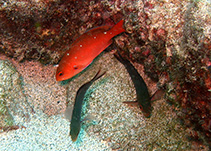| Family: |
Epinephelidae (Groupers) |
| Max. size: |
30 cm SL (male/unsexed) |
| Environment: |
reef-associated; marine; depth range 8 - 100 m |
| Distribution: |
Eastern Atlantic: Ascension Island and Gulf of Guinea islands of Principe, São Tomé, and Annobon. Western Atlantic: Bermuda, Florida, Gulf of Mexico, Campeche Bank, and throughout the Caribbean (except in northern Bahamas) to Sao Paulo, Brazil. |
| Diagnosis: |
Dorsal spines (total): 9-9; Dorsal soft rays (total): 17-19; Anal spines: 3-3; Anal soft rays: 8-10. Distinguished by the following characteristics: Head short (less than 35% of SL) (Ref. 26938); head and body reddish brown, paler ventrally; bright orange-red spot at the upper end of the pectoral-fin base; 3 widely spaced white spots between lateral line and dorsal-fin base; 2 blue lines on the cheek, one approximately horizontal and tangential to the lower edge of the eye, other along the upper edge of maxilla and continued onto the lower part of the cheek; depth of body contained 2.9-3.4 times in SL; subangular preopercle, vertical edge and rear half of lower edge finely serrate; subequal posterior and anterior nostrils (Ref. 89707). |
| Biology: |
Inhabits coral reefs and hard bottom areas. Observed in feeding aggregations well above the reef. Feeds mainly in midwater on zooplankton (copepods, pelagic tunicates, shrimps and shrimp larvae). Retreats instantly when alarmed (Ref. 9710). |
| IUCN Red List Status: |
Least Concern (LC); Date assessed: 02 November 2017 Ref. (130435)
|
| Threat to humans: |
harmless |
Source and more info: www.fishbase.org. For personal, classroom, and other internal use only. Not for publication.
